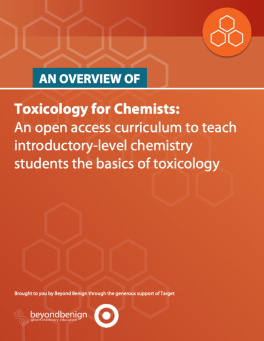07 - Environmental Fate, Persistence, and Biodegradation (Toxicology for Chemists - Module 7)

Summary
This module contains an introduction to the concepts of fate, persistence, and biodegradation. Students will learn about: classes of molecules that persist in the environment; different types of degradation and their critical role in the environment and society; and parameters that affect biodegradation rate. Part II of this module is a full case study entirely based on the Deepwater Horizon oil spill. The remaining lecture slides also contain multiple in-class discussions, activities, and smaller case studies.
What’s included?
Lectures:
“7ABC – Environmental Fate, Persistence and Biodegradation” (3-4 hours)
Lesson Plans:
For all lectures
Supplementary Information:
Deepwater Horizon oil spill full case study (1 hour)
Materials for students to complete the case study assignment
File Size: 165 MB – this file is large, please ensure you have good internet connectivity before downloading.
This course module was authored by:
Dr. Karolina Mellor, Program Manager, Yale Center for Green Chemistry and Green Engineering
Dr. Predrag Petrovich, Associate Research Scientist, Yale Center for Green Chemistry and Green Engineering
The content of this module was reviewed by:
Dr. Alexandra Weissfloch, Professor, Vancouver Island University
Dr. David A. Laviska, Assistant Professor, Seton Hall University
What’s included?
Lectures:
“7ABC – Environmental Fate, Persistence and Biodegradation” (3-4 hours)
Lesson Plans:
For all lectures
Supplementary Information:
Deepwater Horizon oil spill full case study (1 hour)
Materials for students to complete the case study assignment
File Size: 165 MB – this file is large, please ensure you have good internet connectivity before downloading.
This course module was authored by:
Dr. Karolina Mellor, Program Manager, Yale Center for Green Chemistry and Green Engineering
Dr. Predrag Petrovich, Associate Research Scientist, Yale Center for Green Chemistry and Green Engineering
The content of this module was reviewed by:
Dr. Alexandra Weissfloch, Professor, Vancouver Island University
Dr. David A. Laviska, Assistant Professor, Seton Hall University
Safety Precautions, Hazards, and Risk Assessment
understanding the concepts and principles of environmental fate, persistence, and biodegradation of a substance is critical to predict its behavior in various matrices.
Digital Object Identifier (DOI)
https://doi.org/10.59877/EIRU9831
Other notes/information
Changed title to try to get modules listed in order by number
File (PDF, PPT, image, etc)
File (PDF, PPT, image, etc)
Creative Commons License

This work is licensed under a Creative Commons Attribution-NonCommercial-ShareAlike 4.0 International License.




